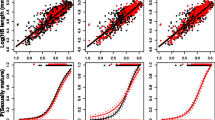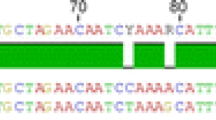Abstract
Although it is well-documented from theoretical studies that pathogens have the capacity to generate cycles, the occurrence and role of pathogens and disease have been poorly empirically studied in cyclic voles and lemmings. In screening for the occurrence of disease in cyclic vole and lemming populations, we found that a high proportion of live-trapped Clethrionomys glareolus, C. rufocanus, Microtus agrestis and Lemmus lemmus at high collective peak density, shortly before the decline, suffered from diabetes or myocarditis in northern Scandinavia. A high frequency of animals had abnormal blood glucose (BG) levels at the time of trapping (5–33%). In contrast, C. rufocanus individuals tested at a much lower overall density, and at an earlier stage relative to the decline in the following cycle, showed normal BG concentrations. However, a high proportion (43%) of a sample of these individuals kept in captivity developed clinical diabetes within five weeks, as determined by BG levels and a glucose tolerance test performed at that later time. A new picornavirus isolated from the rodents, Ljungan virus (LV), was assumed to cause the diseases, as LV-induced diabetes and myocarditis, as well as encephalitis and fetal deaths, were observed in laboratory mice. We hypothesize that LV infection significantly affects morbidity and mortality rates in the wild, either directly or indirectly, by predisposing the rodents to predation, and is at least involved in causing the regular, rapid population declines of these cyclic voles and lemmings. Increased stress at peak densities is thought to be an important trigger for the development of disease, as the occurrence of disease in laboratory mice has been found to be triggered by introducing stress to LV-infected animals.
Similar content being viewed by others
References
Agrell J, Erlinge S, Nelson J, Nilsson C, Persson I (1995) Delayed density-dependence in a small-rodent population. Proc R Soc Lond B 262:65–70
Anderson RM, May RM (1978) Regulation and stability of host-parasite population interactions. I. Regulatory processes. J Anim Ecol 47:219–247
Batzli GO (2001) Dynamics of small mammal populations: a review. In: McCullough DR, Barret RH (eds) Wildlife 2001: populations. Elsevier, Amsterdam, pp 831–850
Begon M, Feore SM, Bown K, Chantrey J, Jones T, Bennett M (1998) Population and transmission dynamics of cowpox in bank voles: testing fundamental assumptions. Ecol Lett 1:82–86
Begon M, Hazel SM, Baxby D, Bown K, Cavanagh R, Chantrey J, Jones T, Bennett M (1999) Transmission dynamics of a zoonotic pathogen within and between wildlife host species. Proc R Soc Lond B 266:1939–1945
Cavanagh RD, Lambin X, Ergon T, Bennett M, Graham IM, van Soolingen D, Begon M (2004) Disease dynamics in cyclic populations of field voles (Microtus agrestis): cowpox virus and vole tuberculosis (Mycobacterium microti). Proc R Soc Lond B 271:859–867
Chitty D (1954) Tuberculosis among wild voles: with a discussion of other pathological conditions among certain mammals and birds. Ecology 35:227–237
Descoteaux J-P, Mihok S (1986) Serologic study on the prevalence of murine viruses in a population of wild meadow voles (Microtus pennsylvanicus). J Wildl Dis 22:314–319
Elton C (1942) Voles, mice and lemmings. Clarendon, Oxford (reprinted in 1965)
Elton C, Davis DHS, Findlay GM (1935) An epidemic among voles (Microtus agrestis) on the Scottish border in the spring of 1934. J Anim Ecol 4:277–288
Feore SM, Bennett M, Chantrey J, Jones T, Baxby D, Begon M (1997) The effect of cowpox virus infection on fecundity in bank voles and wood mice. Proc R Soc Lond B 264:1457–1461
Freimanis T, Heller KE, Schoenecker B, Bildsoe M (2003) Effects of preweaning stress on the development of type 1 diabetes in bank voles (Clethrionomys glareolus). Int J Exp Diabesity Res 4:21–25
Gilg O, Hanski I, Sittler B (2003) Cyclic dynamics in a simple vertebrate predator–prey community. Science 302:866–868
Graham IM, Lambin X (2002) The impact of weasel predation on cyclic field-vole survival: the specialist predator hypothesis contradicted. J Anim Ecol 71:946–956
Hanski I, Henttonen H (1996) Predation on competing rodent species: a simple explanation of complex patterns. J Anim Ecol 65:220–232
Hanski I, Henttonen H, Korpimäki E, Oksanen L, Turchin P (2001) Small-rodent dynamics and predation. Ecology 82:1505–1520
Hansson L, Henttonen H (1985) Gradients in density variations of small rodents: the importance of latitude and snow cover. Oecologia 67:394–402
Hansson L, Henttonen H (1988) Rodent dynamics as community processes. Trends Ecol Evol 3:195–200
Hudson P J, Bjørnstad ON (2003) Vole stranglers and lemming cycles. Science 302:797–798
Hudson PJ, Dobson AP, Newborn D (1992) Do parasites make prey vulnerable to predation? Red grouse and parasites. J Anim Ecol 61:681–692
Hudson PJ, Dobson AP, Newborn D (1998) Prevention of population cycles by parasite removal. Science 282:2256–2258
Hörnfeldt B (1994) Delayed density dependence as a determinant of vole cycles. Ecology 75:791–806
Hörnfeldt B (2004) Long-term decline in numbers of cyclic voles in boreal Sweden: analysis and presentation of hypotheses. Oikos 107:376–392
Hörnfeldt B (2006) Miljöövervakning av smådäggdjur. Birger Hörnfeldt, Umeå University, Sweden (see http://www.emg.umu.se/personal/lankar/hornfeldt/index3.html, last accessed 4th July 2006)
Hörnfeldt B, Löfgren O, Carlsson B-G (1986) Cycles in voles and small game in relation to variations in plant production indices in northern Sweden. Oecologia 68:496–502
Hörnfeldt B, Carlsson B-G, Löfgren O, Eklund U (1990) Effects of cyclic food supply on breeding performance in Tengmalm’s owl (Aegolius funereus). Can J Zool 68:522–530
Johansson ES, Niklasson B, Tesh RB, Shafren DR, Travassos da Rosa APA, Lindberg AM (2003) Molecular characterization of M1146, an American isolate of Ljungan virus (LV) reveals the presence of a new LV genotype. J Gen Virol 84:837–844
Johnson HN (1965) Diseases derived from wildlife. Calif Health 23:35–39
Korpimäki E, Norrdahl K (1998) Experimental reduction of predators reverses the crash phase of small-rodent cycles. Ecology 79:2448–2455
Korpimäki E, Norrdahl K, Klemola T, Pettersen T, Stenseth NC (2002) Dynamic effects of predators on cyclic voles: field experimentation and model extrapolation. Proc R Soc Lond B 269:991–997
Korpimäki E, Klemola T, Norrdahl K, Oksanen L, Oksanen T, Banks PB, Batzli GO, Henttonen H (2003) Vole cycles and predation. Trends Ecol Evol 18:494–495
Lambin X, Graham IM (2003) Testing the specialist predator hypothesis for vole cycles. Trends Ecol Evol 18:493
Main AJ, Shope RE, Wallis RC (1976) Characterization of Whitney’s Clethrionomys gapperi virus isolates from Massachusetts. J Wildl Dis 12:154–164
May RM (1981) Models for single populations. In: May RM (ed) Theoretical ecology: principles and applications, 2nd edn. Blackwell, Oxford, pp 5–24
May RM, Anderson RM (1978) Regulation and stability of host-parasite population interactions. II. Destabilizing processes. J Anim Ecol 47:249–267
Mihok S, Turner BN, Iverson SL (1985) The characterization of vole population dynamics. Ecol Monogr 55:399–420
Niklasson B, Hörnfeldt B, Lundkvist Å, Björsten S, LeDuc J (1995) Temporal dynamics of Puumala virus antibody prevalence in voles and of nephropathia epidemica incidence in humans. Am J Trop Med Hyg 53:134–140
Niklasson B, Hörnfeldt B, Lundman B (1998) Could myocarditis, insulin-dependent diabetes mellitus, and Guillain–Barré syndrome be caused by one or more infectious agents carried by rodents? Emerg Infect Dis 4:187–193
Niklasson B, Kinnunen L, Hörnfeldt B, Hörling J, Benemar C, Hedlund KO, Matskova L, Hyypiä T, Winberg G (1999) A new picornavirus isolated from bank voles (Clethrionomys glareolus). Virology 255:86–93
Niklasson B, Heller KE, Schoenecker B, Bildsoe M, Daniels T, Hampe CS, Widlund P, Simonson WT, Schaefer JB, Rutledge E, Bekris L, Lindberg M, Johansson S, Örtqvist E, Persson B, Lernmark Å (2003a) Development of type 1 diabetes in wild bank voles associated with islet autoantibodies and the novel Ljungan virus. Int J Exp Diabesity Res 4:35–44
Niklasson B, Hörnfeldt B, Nyholm E, Niedrig M, Donoso-Mantke O, Gelderblom HR, Lernmark Å (2003b) Type1 diabetes in Swedish bank voles (Clethrionomys glareolus): signs of disease in both colonized and wild cyclic populations at peak density. Ann NY Acad Sci 1005:170–175
Niklasson B, Samsioe S, Blixt M, Sandler S, Sjöholm Å, Lagerquist E, Lernmark Å, Klitz W (2006) Prenatal viral exposure followed by adult stress produces glucose intolerance in a mouse model. Diabetologia (in press)
Oli MK (2003a) Population cycles of small rodents are caused by specialist predators: or are they? Trends Ecol Evol 18:105–107
Oli MK (2003b) Response to Korpimäki et al.: vole cycles and predation. Trends Ecol Evol 18:495–496
Samsioe A, Feinstein R, Saade G, Sjöholm Å, Hörnfeldt B, Fundele R, Klitz W, Niklasson B (2006) Intrauterine death, fetal malformation, and delayed pregnancy in Ljungan virus-infected mice. Birth Defects Res Part B 77 (in press)
Schoenecker B, Heller KE, Freimanis T (2000) Development of stereotypes and polydipsia in wild caught bank voles (Clethrionomys glareolus) and their laboratory-bred offspring: is polydipsia a symptom of diabetes mellitus? Appl Anim Behav Sci 68:349–357
Soveri T, Henttonen H, Rudbäck E, Schildt R, Tanskanen R, Husu-Kallio J, Haukisalmi V, Sukura A, Laakkonen J (2000) Disease patterns in field and bank vole populations during a cyclic decline in central Finland. Comp Immunol Microbiol Infect Dis 23:73–89
Stenseth NC (1999) Population cycles in voles and lemmings: density dependence and phase dependence in a stochastic world. Oikos 87:427–461
Stenseth NC, Ims RA (1993) Population dynamics of lemmings: temporal and spatial variation—an introduction. In: Stenseth NC, Ims RA (eds) The biology of lemmings. Academic, London, pp 61–96
Telfer S, Bennett M, Bown K, Cavanagh R, Crespin L, Hazel S, Jones T, Begon M (2002) The effects of cowpox virus on survival in natural rodent populations: increases and decreases. J Anim Ecol 71:558–568
Telfer S, Bennett M, Bown K, Carslake D, Cavanagh R, Hazel S, Jones T, Begon M (2005) Infection with cowpox virus decreases female maturation rates in wild populations of woodland rodents. Oikos 109:317–322
Whitney E, Roz AP, Rayner GA (1970) Two viruses isolated from rodents (Clethrionomys gapperi and Microtus pennsylvanicus) trapped in St. Lawrence County, New York. J Wildl Dis 6:48–55
Acknowledgments
Åke Vikström, Robert Franzén, Jan Stuge, Alf Kjellström, Christer Edsholm, Lars Liljemark, Bert-Ivan Mattsson, and Anders Östergren are thanked for helping to catch the animals, and Jonas Gustafsson also for caring for them. The manuscript was improved by comments from Lennart Hansson, William Klitz, Charles Krebs, Kjell Leonardsson, Åke Norberg, Staffan Ulfstrand, the anonymous referees, and by Tim Hipkiss who improved the English. Financial support was received by BH from the Swedish Environmental Protection Agency. Experiments comply with current Swedish laws and were approved by the Animal Experiment Ethics Committees at the Karolinska Institute (N340/01, N341/01), Stockholm, and at Umeå University (A57–99 and A46–02), Umeå, Sweden.
Author information
Authors and Affiliations
Corresponding author
Additional information
Communicated by Hannu Ylonen
Rights and permissions
About this article
Cite this article
Niklasson, B., Nyholm, E., Feinstein, R.E. et al. Diabetes and myocarditis in voles and lemmings at cyclic peak densities—induced by Ljungan virus?. Oecologia 150, 1–7 (2006). https://doi.org/10.1007/s00442-006-0493-1
Received:
Accepted:
Published:
Issue Date:
DOI: https://doi.org/10.1007/s00442-006-0493-1




